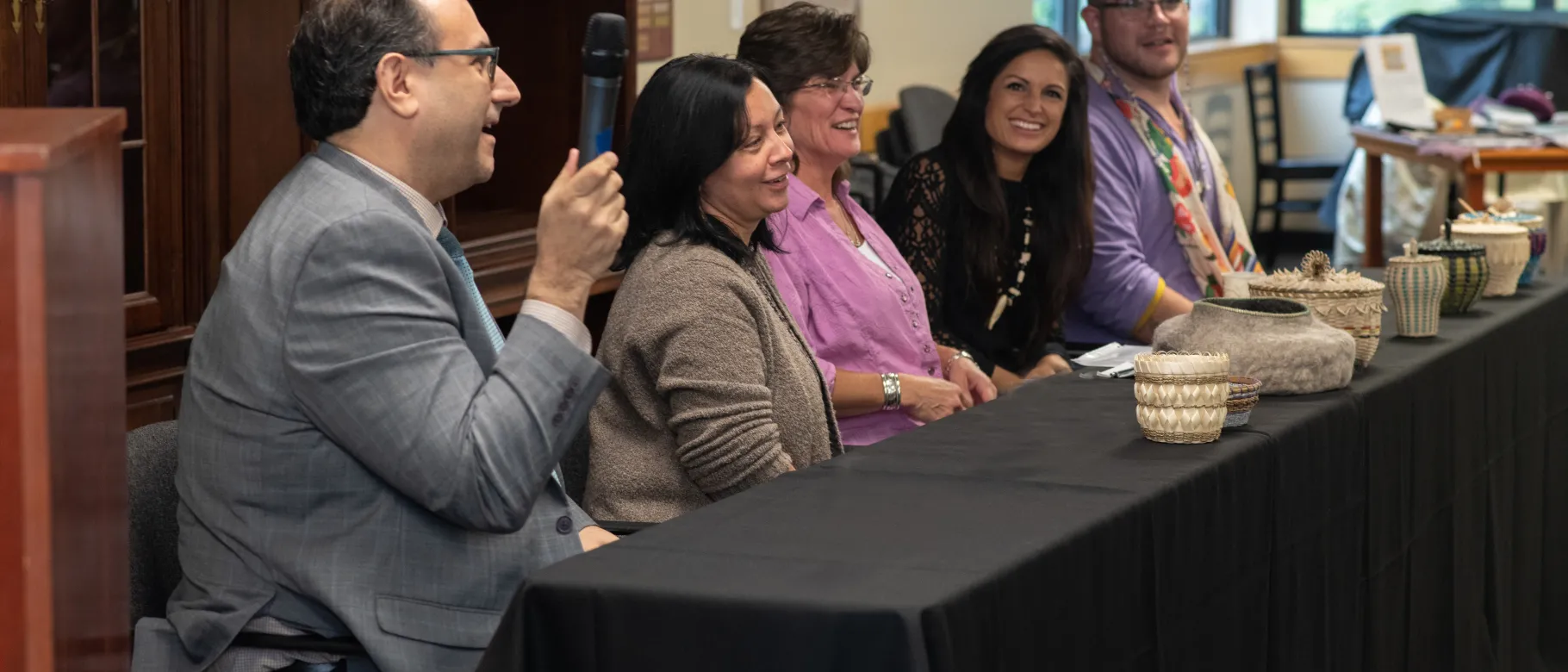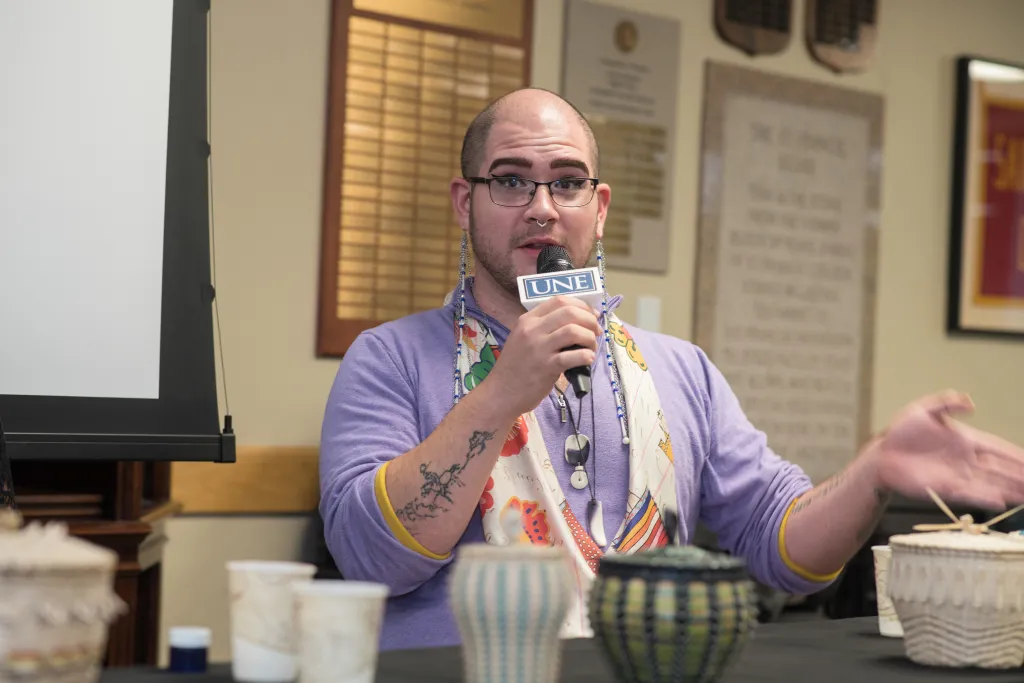Maine Women Writers Collection event presents endangered art of Wabanaki basketmaking

On October 1, UNE’s Maine Women Writers Collection sponsored an event as part of its annual Donna M. Loring Lecture Series, titled, “Wabanaki Basketmaking Traditions Under Threat? Art, Culture, and the Future of Maine Indian Basketmaking.” The event presented the centuries-old artistic tradition of basketmaking among the Wabanaki peoples (the Passamaquoddy, Penobscot, Abenaki, Mi’kmaq and Maliseet), while shedding light on the potentially devastating effect that a specific invasive insect species, the emerald ash borer, may soon have on this important Native craft.
The event featured a panel of award-winning Wabanaki basketmakers who discussed their unique approaches to basketmaking and the special meaning that the art has to them and their tribal communities. They also spoke about how their peoples are responding to the destruction wreaked by the emerald ash borer on the traditional tree species used in Wabanaki basketry: black ash or basket ash (Fraxinus nigra), more commonly known in Maine as brown ash.
Darren Ranco, Ph.D., chair of Native American Programs at the University of Maine, moderated the panel discussion and shared his expertise on the emerald ash borer. He recounted the history of the species in North America, noting that it first came to the continent from China in the 1990s via shipping palettes that arrived in the port of Detroit. According to Ranco, it is the reproduction cycle of the insect that is deadly to ash trees. The ash borer lays its eggs underneath the thick and porous bark of the ash, and the resulting larvae feed on the tree’s nutrients, ultimately leading to the tree’s demise. The species has spread to 35 states and four Canadian provinces, resulting in the death of more than 150 million ash trees.
Ranco reported that the species was discovered in Maine five years ago and has a natural spread of 750 meters per year. Unnatural spread, mainly the result of transportation of firewood, accelerates the problem, he said. In August, the Maine Department of Agriculture, Conservation and Forestry issued an emergency order restricting the movement of ash products in parts of the state. Ranco expects that later in the year, a quarantine will be issued that will impact additional areas.
The basketmakers discussed some of the measures that the Wabanaki peoples are taking in anticipation of a day when brown ash may not be accessible, noting that they are storing seeds, planting trees and setting “tree traps” (to lure the insects in one direction rather than another). They also have created detailed videos demonstrating of all aspects of traditional brown ash basketmaking (from planting to weaving) so that if brown ash obliteration lasts throughout a generation or more, a future generation will to be able to learn the craft in the event that a brown ash resurgence ever were to occur. “No one in the world is more prepared for the arrival of the emerald ash borer than the Wabanaki people,” stated basketmaker Geo Neptune.
The basketmakers also discussed the ways in which they are experimenting with other materials to create their baskets. In fact, each of the artists presented one basket made of predominantly brown ash as well as one basket made of an alternative material. Some artists like Jennifer Neptune and Pam Outdusis Cunningham have turned to other natural materials like cedar and wool, respectively. Others have dabbled in unnatural materials or a combination of natural and unnatural. Geo Neptune presented a basket made of venetian blinds, bamboo, yarn, ribbon, and epoxy glue, while Sarah Sockbeson showed off her alternative material basket fashioned from fabric, wallpaper, glue, cordage and acrylic paint.
UNE Professor Tom Klak, Ph.D., from the Department of Environmental Studies, was present at the event and asked the panel about differentiation among the three types of ash: brown, white and green. The basketmakers reported that white and green ash, the types more common in Southern Maine, are too brittle for weaving. Only the brown ash, which grows in wet, swampy areas, is supple enough to be made into baskets.
While acknowledging that the brown ash is by far a superior material for their purposes, the Wabanaki basketmakers are prepared to use substitutes if demanded by ash borer destruction. Even if they find themselves without their traditional material, they said, they are steadfast in their determination to continue the art of basketmaking. “It is important to me that I utilize traditional materials and that I have a strong foundation in that,” said Sockbeson, “but if we come to a place where the material is scarce, I think we have to keep this tradition alive, no matter what. Even if we don’t have the material, I think we still have something that is valuable and something that is very worth sharing and worth perpetuating.”
About the Donna M. Loring Lecture Series
The Donna M. Loring Lecture Series, sponsored by the Maine Women Writers Collection, addresses current or historic Native American or aboriginal issues, indigenous rights, as well as women’s issues, civil rights, and issues of fairness and equality as they overlap with the concerns of tribal peoples. The University of New England’s Maine Women Writers Collection in 2009 announced the acquisition of the Loring's personal and literary papers. This acquisition is the first given by a Native American woman to the University’s collections. It enriches the women’s literary collections preserved in the MWWC facility for research and study, and it signals a new direction in the acquisition of papers of women authors from very significant yet underrepresented groups.
